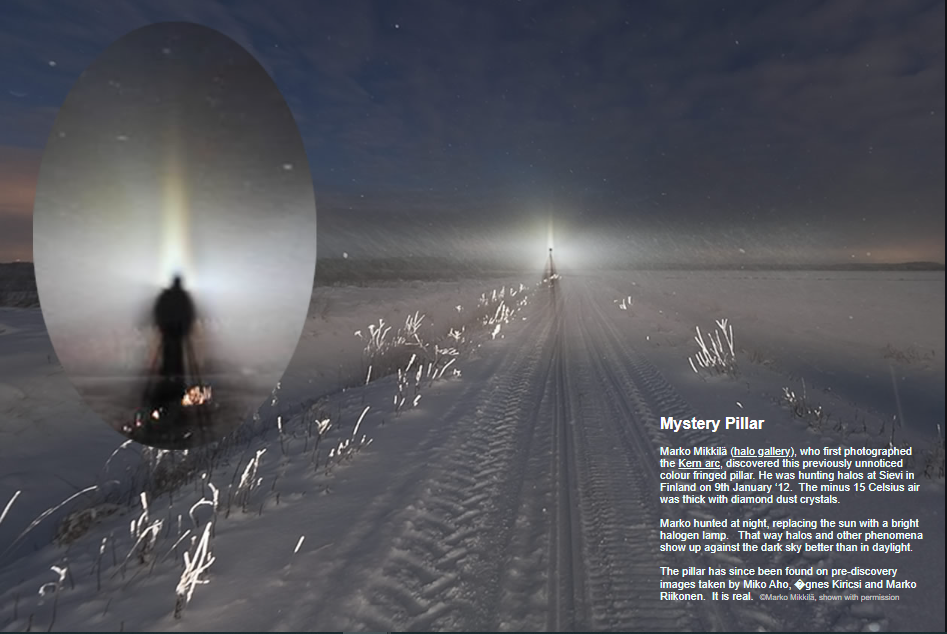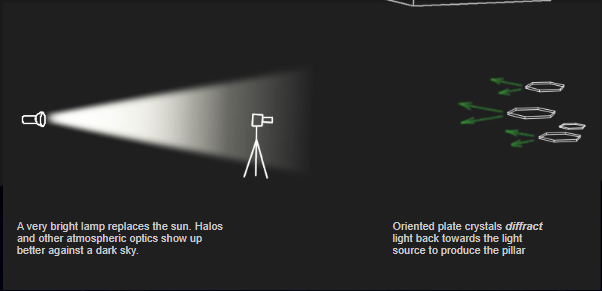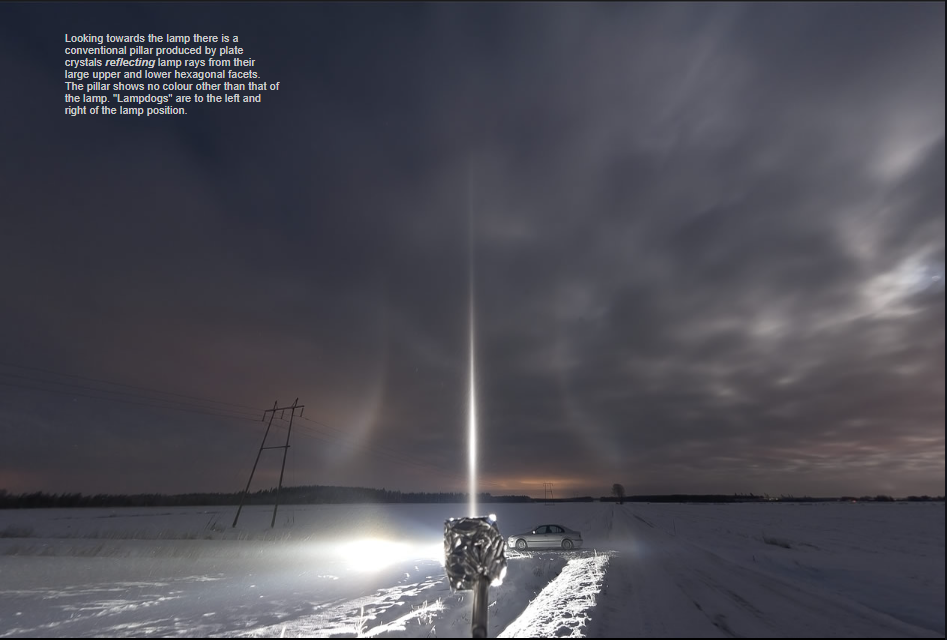OPOD - Mystery Pillar
OPOD - Mystery Pillar: Exploring the Enigmatic Atmospheric Phenomenon
Have you ever come across a captivating atmospheric optical phenomenon that left you in awe? One such intriguing phenomenon is the "Mystery Pillar," which was first discovered by Marko Mikkilä, a talented photographer and halo enthusiast. On a chilly winter night in Sievi, Finland, back in January 2012, Marko stumbled upon this previously unnoticed color-fringed pillar while hunting for halos. The air was frigid, with temperatures plummeting to -15 degrees Celsius, and the atmosphere was filled with diamond dust crystals, creating the perfect conditions for optical wonders to unfold.
Marko's approach to capturing atmospheric phenomena involved using a bright halogen lamp as a substitute for the sun. By conducting his observations at night, against the backdrop of a dark sky, he could better discern halos and other atmospheric optics. Little did he know that his quest for halos would lead him to the discovery of an extraordinary phenomenon – the Mystery Pillar.
Unveiling the Nature of the Mystery Pillar
Upon its discovery, experts in the field of atmospheric optics were puzzled by the nature of the Mystery Pillar. Unlike conventional reflection or refraction pillars that appear immediately above and below the sun (or lamp), this newly found pillar stood opposite to the light source, where shadows converge. Its unique location sparked curiosity and raised questions about its origin.
The enigma deepened when attempts to reproduce the Mystery Pillar using ray tracing simulations failed. Known crystal forms and orientations could not account for this peculiar phenomenon. However, some halos remain unexplained, leaving room for speculation.
To unravel the secrets behind the Mystery Pillar, experts turned their attention to important clues hidden within its appearance. Faint color fringes on the sides of the pillar and its location opposite the lamp/sun, where colorful glories often manifest, hinted at a possible diffraction backscattering effect similar to the glory phenomenon. In fact, the pillar's fiery ascent from the shadow of Marko's head reminded observers of the Brocken Spectre shadow and its surrounding glory.
Deciphering the Mechanics: Hexagonal Plate Crystals and Diffraction
While a diffraction mechanism seemed plausible, the elongated shape of the Mystery Pillar posed a challenge. Small non-spherical objects, such as pollen grains or ice crystals, typically produce non-circular diffraction patterns. However, none had been observed to exhibit such an elongated shape opposite the light source.
Nevertheless, observations of other halos visible at the time hinted at the potential involvement of hexagonal plate crystals. This insight led to the next phase of investigation – testing this hypothesis. However, studying plate crystals' non-spherical geometry proved to be no easy task.
Nicolas Lefaudeux, a researcher from France, stepped in to tackle this challenge. He employed Finite Difference Time Domain (FDTD) computations, a cutting-edge technique used to compute scattering by complex photonic crystals. FDTD involves time-wise integration of Maxwell's equations, which describe the fundamental principles of electromagnetism. These computations can accurately predict macroscopic phenomena by incorporating refraction, diffraction, surface waves, and more.
By simulating backscattering by plate-oriented crystals using FDTD computations, Lefaudeux managed to produce a pillar similar to the observed Mystery Pillar. The simulations involved plate crystals measuring 32 microns across and 2.5 microns thick, resulting in a 5° high pillar with distinct color fringes. Further refinements of the model, particularly incorporating larger yet thin crystals, are expected to improve the match even further.
A Tentative Name: Subanthelic Diffraction Pillar
Based on these findings, it is highly likely that the Mystery Pillar is a result of backscattering from oriented hexagonal plate crystals. In light of this discovery, it has been tentatively named a "subanthelic diffraction pillar." This captivating phenomenon serves as a reminder that there is much more to the heavens and earth than what we can fathom with our current understanding.
Shakespeare's Hamlet once said, "There are more things in heaven and earth, Horatio, than are dreamt of in your philosophy." The Mystery Pillar is a testament to the ongoing exploration of the skies and the endless wonders that await our discovery.
As we continue to gaze at the ever-changing tapestry of the atmosphere, let us remain open to the possibility of encountering more sky sights that have yet to be dreamed of. The Mystery Pillar serves as a reminder that the realm of atmospheric optics holds countless secrets, waiting to be unraveled by inquisitive minds and passionate observers.
Note: This article has been automatically converted from the old site and may not appear as intended. You can find the original article here.

Mystery Pillar
Marko Mikkilä (halo gallery), who first photographed the Kern arc, discovered this previously unnoticed colour fringed pillar. He was hunting halos at Sievi in Finland on 9th January ‘12. The minus 15 Celsius air was thick with diamond dust crystals.
Marko hunted at night, replacing the sun with a bright halogen lamp. That way halos and other phenomena show up against the dark sky better than in daylight.
The pillar has since been found on pre-discovery images taken by Miko Aho, �gnes Kiricsi and Marko Riikonen. It is real. ©Marko Mikkilä, shown with permission

Top: Enhanced image to show colour fringes
Right: FTDT simulation by Nicolas Lefaudeux of backscattering by thin hexagonal plate crystals.
Unlike a conventional reflection/refraction pillar, the crystals need not be tilted. Their extended horizontal profile produces a vertically elongated diffraction pattern.

A very bright lamp replaces the sun. Halos and other atmospheric optics show up better against a dark sky.
Oriented plate crystals diffract light back towards the light source to produce the pillar
What is it?
Halo experts were puzzled. Ordinary pillars, glints from plate or column ice crystals, are immediately above and below the sun (or lamp, see one at page bottom). The new pillar is opposite the sun/lamp in the direction to which shadows converge.
It is unlikely to be an ice halo produced by refraction and reflection because it cannot be reproduced in ray tracing simulations using known crystal forms and orientations. That, of course, is not definite proof because some halos still await explanation.
Important clues to its origin were the faint colour fringes at the pillar sides and its location opposite the lamp/sun where colourful glories shine. They suggest a diffraction backscattering effect like the glory, in fact the apparition - a pillar flaming upwards from the shadow of Marko's head - reminds us of a Brocken Spectre shadow and its surrounding glory.
The problem with a diffraction mechanism is the pillar�s shape. Small non-spherical objects, pollen grains, ice crystals produce non-circular diffraction patterns but not elongated to this extent nor opposite the sun.
Nonetheless, from halos also visible at the time it seemed that hexagonal plate crystals might be the culprits. The next challenge was to test this possibility. Not easy because of plate crystals� non-spherical geometry. Then Nicolas Lefaudeux from France stepped in and applied Finite Difference Time Domain (FDTD) computations, a modern technique used, for example, to compute scattering by complex photonic crystals.
FDTD is a brute force time-wise integration of Maxwell's equations, the fundamental equations of electromagnetism. The finite difference method has to employ a computational mesh small enough to describe light waves yet also encompass the scattering crystal enormous by comparison. Computer demands are therefore huge. The calculations quite naturally incorporate refraction, diffraction, surface waves and so on. They can accurately predict what we see in our macro world. But we always want more! We like high level, easy to visualise, mechanistic explanations of what is happening. Like earlier Mie-Lorenz theory, FDTD provides no such comfort. The story of the glory repeats itself.
Nicolas Lefaudeux performed calculations for backscattering by plate oriented crystals. At left is an example for plates 32 micron across and 2.5 micron thick. The 5° high pillar with colour fringes is similar to that observed. Refinements of the model, particularly use of larger but thin crystals, are expected to further improve the match.
The new pillar is therefore almost certainly a backscattering effect from oriented hexagonal plate crystals. It has been tentatively named a 'subanthelic diffraction pillar'.
Hamlet: ".. And therefore as a stranger give it welcome. There are more things in heaven and earth, Horatio, than are dreamt of in your philosophy." May we see more sky sights we have yet undreamed of.

The backscattered diffraction pillar in the direction looking away from the lamp. Each side has a coloured fringe.

Looking towards the lamp there is a conventional pillar produced by plate crystals reflecting lamp rays from their large upper and lower hexagonal facets. The pillar shows no colour other than that of the lamp. "Lampdogs" are to the left and right of the lamp position.
Note: this article has been automatically converted from the old site and may not appear as intended. You can find the original article here.
Reference Atmospheric Optics
If you use any of the definitions, information, or data presented on Atmospheric Optics, please copy the link or reference below to properly credit us as the reference source. Thank you!
-
<a href="https://atoptics.co.uk/blog/opod-mystery-pillar/">OPOD - Mystery Pillar</a>
-
"OPOD - Mystery Pillar". Atmospheric Optics. Accessed on December 22, 2024. https://atoptics.co.uk/blog/opod-mystery-pillar/.
-
"OPOD - Mystery Pillar". Atmospheric Optics, https://atoptics.co.uk/blog/opod-mystery-pillar/. Accessed 22 December, 2024
-
OPOD - Mystery Pillar. Atmospheric Optics. Retrieved from https://atoptics.co.uk/blog/opod-mystery-pillar/.